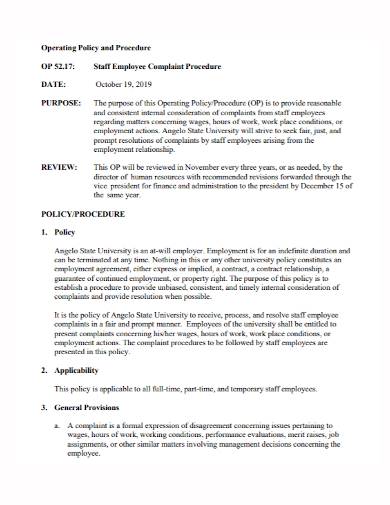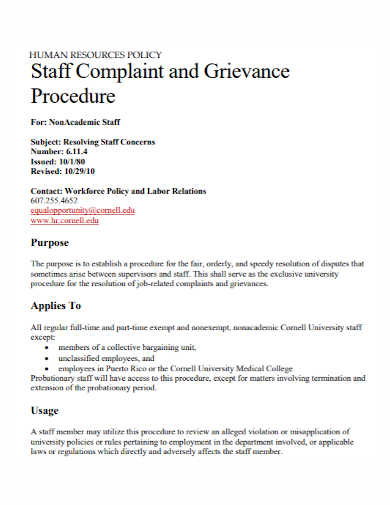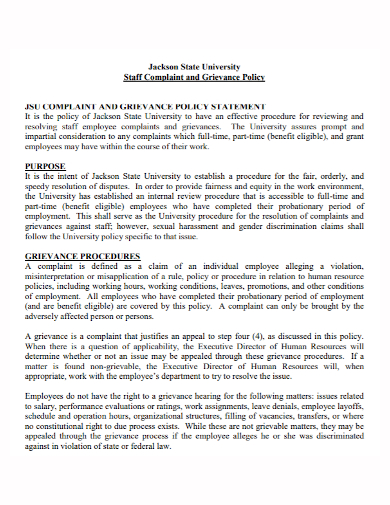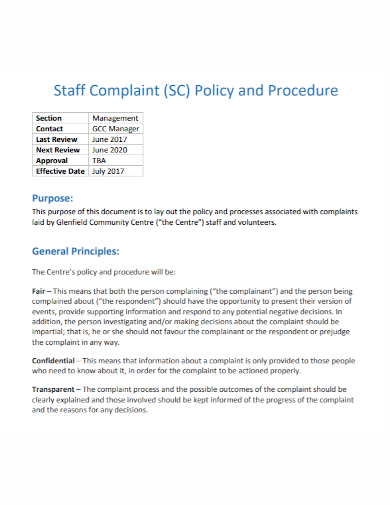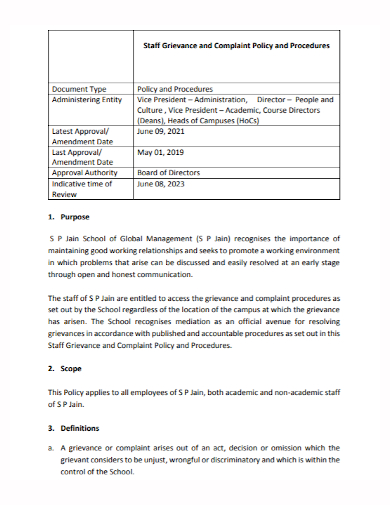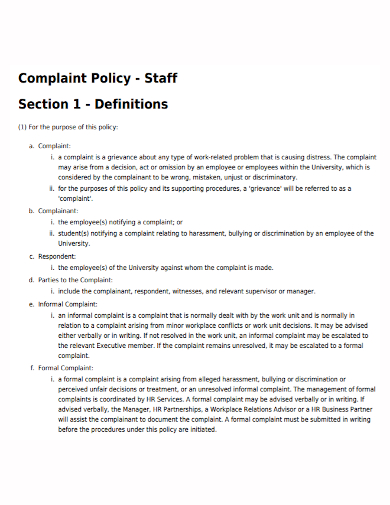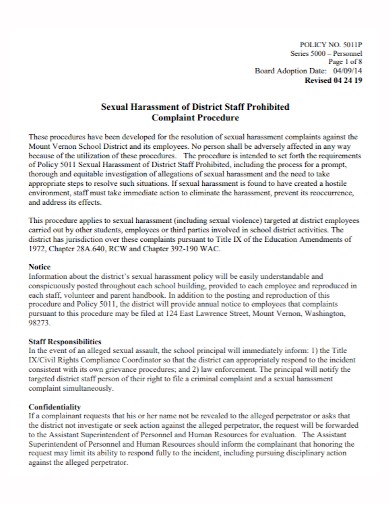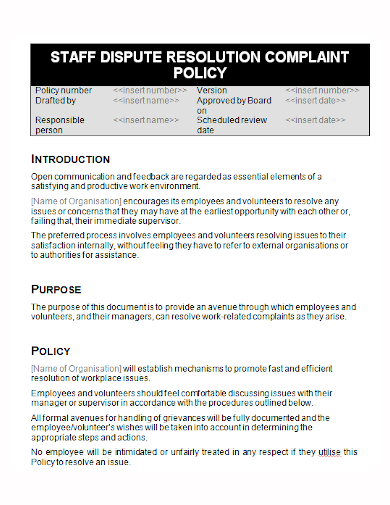No company in the world hasn’t encountered complaints from its staff. The chances of having negative interactions and experiences for staff to experience are always present especially if the staff number is high. For companies to handle complaints diplomatically, a complaint policy should be written to help develop a complaint procedure. The procedure, where the complainant can air out their complaints in a systematic manner to the person in charge of dealing with the complaints to provide steps on resolving the issue, is important to have an organized system to avoid escalating the problem. If you’re a small business and haven’t developed a complaint policy, now is the time to do it. Read the article to find out what a complaint policy looks like and how to create one.
10+ Staff Complaint Policy Samples
1. Staff Complaint Procedure Policy
2. Staff Employee Complaint Procedure Policy
3. Staff Complaint Grievance Policy
4. Staff Complaint Grievance Policy Statement
5. Management Staff Complaint Policy
6. Staff Complaint Grievance Procedure Policy
7. Sample Staff Complaint Policy
8. Formal Staff Complaint Policy
9. Staff Sexual Harassment Complaint Policy
10. Staff Resolution Complaint Policy
11. School Staff Grievance Complaint Policy
What is a Staff Complaint?
A staff complaint is any type of problem, concern, or grievance raised by the employees of a company or an organization about work or the work environment they are in. Most staff complaints are problems concerning the conduct of another staff member such as interpersonal conflict, discrimination, harassment, and bullying. Sometimes staff complaints raise awareness on workplace safety or environmental issues.
Details to Include in a Staff Complaint Policy
The details below are examples of what you can include in your complaint policy. Every company has different procedures and processes in handling complaints and creating policies about them, but this will serve as a guide on what a complaint policy consists of.
1. Purpose of the Policy
The first part of the staff complaint policy is to state the primary reason for issuing the policy. This part doesn’t need to be very long; two to three sentences will suffice. To help you create the purpose section, you can follow what companies put in this part. Most complaint policies in various states that its purpose is concerning employee satisfaction.
2. Scope
This section determines where and to whom the complaint policy applies and who are and which situations are exempted from it.
3. Definition of Terms
The definition of terms is an important section to include in your policy. Place it before you state your policies. This is done to help define some terms that are commonly used throughout the policy to help readers understand its whole meaning and its purpose in the policy.
4. Policy Statement
This part of the complaint policy is where you lay out the policy statement of your company. State what the policy statement is about in a more detailed manner, how the policy addresses the complaint procedure, and how it will benefit your staff. It’s up to you what your complaint policy statement will be, this section can be as long as you need it to be.
5. Procedure of Filing Complaints
For this section, you need to create several steps on how employees file complaints to the person in charge of addressing complaints (usually the human resource officer is responsible for complaints management), how the officer in charge of complaints address the issue with the complainant, and the person they are complaining of, and how they will resolve the issue. Make sure your procedure has an easy process for everyone to follow and make sure to hit the aim of resolving employee complaints to increase the confidence in your employer’s concern for their level of satisfaction.
FAQs
How do you handle staff complaints?
For HR officers and managers to handle complaints from their staff, they need to listen fully to the complaint and ask questions regarding the incident and give advice to the complainant on how they should resolve the situation, and ensure them that actions will be undertaken to address the issues.
How do you resolve a customer complaint?
To resolve a complaint without escalating the issue, one must try to stay calm, listen, be courteous and kind, acknowledge the issue calmly and apologize for the mishaps. It is a difficult thing to do, especially if the customer is particularly irate, but it will somehow help diffuse the tense situation and avoid any more complaints if you get upset and lose your temper. Don’t forget to document their complaints to help aid you when the situation needs to be investigated
What are the different types of employee complaints?
The types of complaints that employees usually raise are sexual harassment, discriminatory harassment, personal harassment, workplace violence, communication issues, management issues, workplace hygiene, and salary issues.
When you develop your complaint policy, it is helpful to review your draft policy statements with your company lawyer to ensure the steps are written in a way that acknowledges federal, state, and local employment laws. This is to avoid any legal matters escalating whenever a complaint is raised. To help you get started writing your own complaint policy, download our sample templates provided above to use as your reference!
Related Posts
FREE 10+ Acknowledgement Statement Samples
FREE 10+ Charity Volunteer Policy Samples
FREE 10+ School Equality Policy Samples
FREE 9+ Disciplinary Memo Templates
FREE 8+ Sample Employee Complaint Forms
FREE 8+ Linking Policy Samples
FREE 8+ Sample Employee Registration Forms
FREE 6+ Harassment Complaint Forms
FREE 18+ Sample HR Forms
FREE 13+ Sample Quality Manuals
FREE 10+ Compensation & Benefit Form Samples
FREE 9+ Sample Complaint Letter
FREE 8+ Sample Employee Notice Forms
FREE 7+ Patient Complaint Forms
FREE 6+ Sample Printable Employee Handbook


